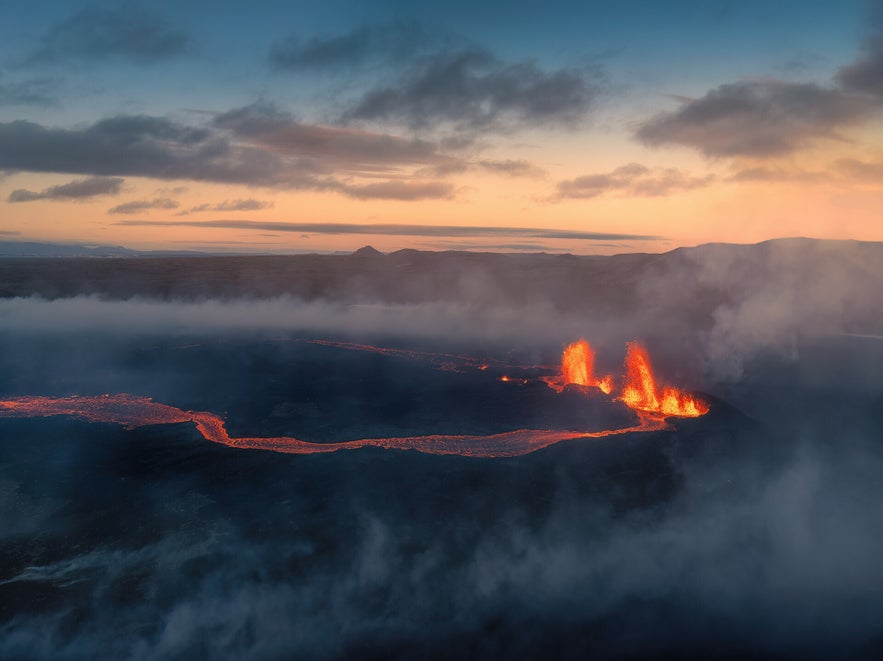Sundhnukagigar Volcano Travel Guide
The Sundhnukagigar crater row is the site of the second 2023 volcanic eruption in Iceland that took place between the 18th and 21st of December. It was followed by a volcanic fissure opening by Mt. Hagafell in January 2024, and both of these have been referred to as the Grindavik eruption because of the closeness to the town and the effects they've had on its infrastructure.
Sundhnukagigar erupted again on February 8th, 2024, followed by even more eruptions the same year, on March 16th, May 29th, August 22nd, and, most recently, on November 20th.
The November 2024 eruption is the tenth eruption in four consecutive years in the vicinity. The previous ones were the Litli-Hrutur eruption in the summer of 2023 and the Fagradalsfjall eruptions of 2021 and 2022.
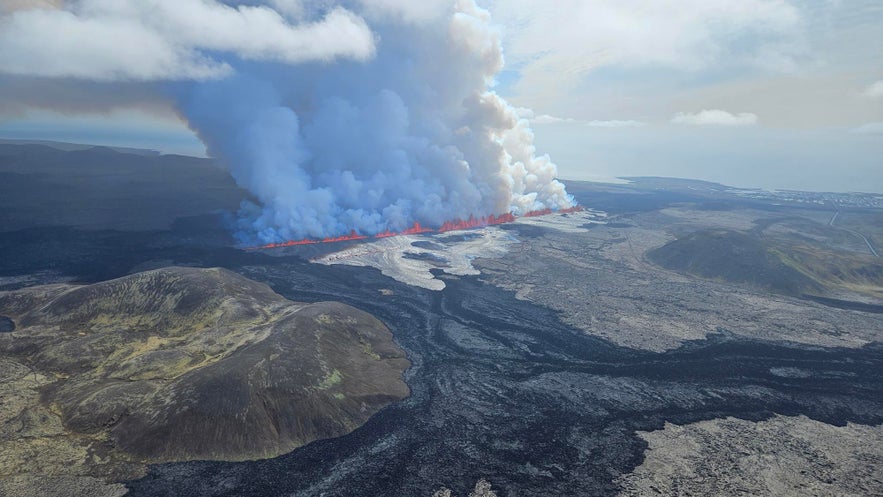
Currently, the area is closed off to the public and can not be visited until authorities consider it safe to do so. Please respect the closure and check the SafeTravel website for updates.
Also, check out our complete guide to the 2023 Sundhnukagigar eruption by Grindavik to learn more about the first eruption, and our guide to the 2024 Sundhnukagigar eruptions for information about the most recent events.
Currently, the only way to see the dramatic aftermath of the previous eruptions and get a glimpse of the Sundhnukagigar eruption site is with this once-in-a-lifetime helicopter tour of the active volcano area. It's a convinient addition to your itinerary if you're staying in accommodation in Reykjavik, as it departs from the Reykjavik Domestic Airport.
- Check out the Complete Guide to the 2024 Hagafell Volcanic Eruption Near Grindavik
- See also: the Guide to the 2023 Eruption of Litli-Hrutur Volcano
- See more about the 2021 Volcanic Eruption by Fagradalsfjall Volcano and the 2022 Fagradalsfjall Volcano Eruption
The 2024 Eruptions by Sundhnukagigar

The start of the 2024 February eruption of Sundhnukagigar craters.
In February 2024, Sundhnukagigar was the site of the sixth eruption on the Reykjanes peninsula in just four years. Just after 6 AM on February 8th, a fissure opened north of Sylingarfell mountain, close to the site of the most recent eruption by Hagafell, lasting about two days before being declared over on February 10th.
The eruption was slightly less powerful than the last eruption, with a fissure of about 1.8 miles (3 kilometers) in length. The eruption did not pose an immediate danger to the town of Grindavik and did not affect the Blue Lagoon or Svartsengi Power Station. However, the lava flow caused damage to roads and hot water pipes in the area.
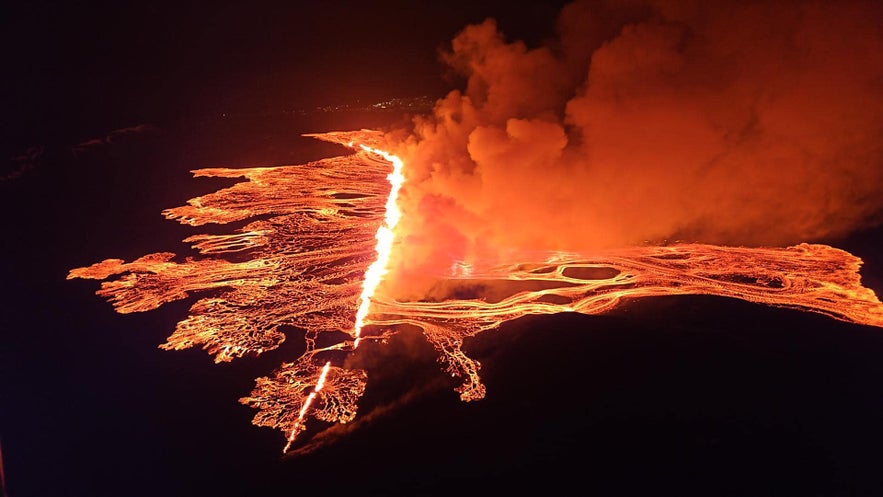
The lava of the 2024 March eruption flowed toward the Grindavik barriers and the Grindavikurvegur road.
A month later, on the evening of March 16th, another eruption began. A 1.8-mile (3-kilometer) fissure opened with very short notice, and the area was quickly evacuated. It was the most powerful eruption so far on the Reykjanes peninsula, and the lava flowed in two directions: to the west towards the Grindavikurvegur road and to the south towards the protective barriers of Grindavik.
Flowing at a speed of 0.6 miles (1 kilometer) per hour, the lava crossed the main Grindavik road and followed the protective barriers. Concerns emerged that the barriers might redirect the lava toward a nearby farmhouse and the ocean, potentially causing toxic fumes and small explosions.
Actions were promptly taken to safeguard the house. Fortunately, the lava flow slowed down, eventually coming to a halt along its path to the ocean. The March eruption was officially declared over on May 8th.
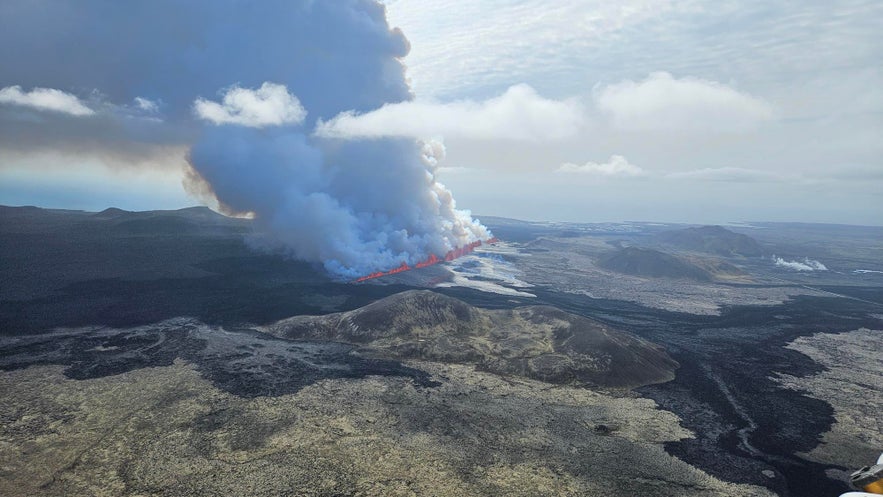 Just 20 days later, it started up again. Around 20 million cubic meters of lava had collected in the ground between the two eruptions, and on May 29th, 2024, a new fissure opened up. It was around 2.1 miles in length (3.4 kilometers), and lava spewed around 164 feet in the air (50 meters).
Just 20 days later, it started up again. Around 20 million cubic meters of lava had collected in the ground between the two eruptions, and on May 29th, 2024, a new fissure opened up. It was around 2.1 miles in length (3.4 kilometers), and lava spewed around 164 feet in the air (50 meters).
The May eruption led to electricity outages in Grindavik and lava flowing over two nearby roads. Lava breached a protective barrier at one location but was cooled and contained by locals using water. The volcanic activity, which mirrored previous eruptions, slowed after the initial days and was declared over on June 22nd.
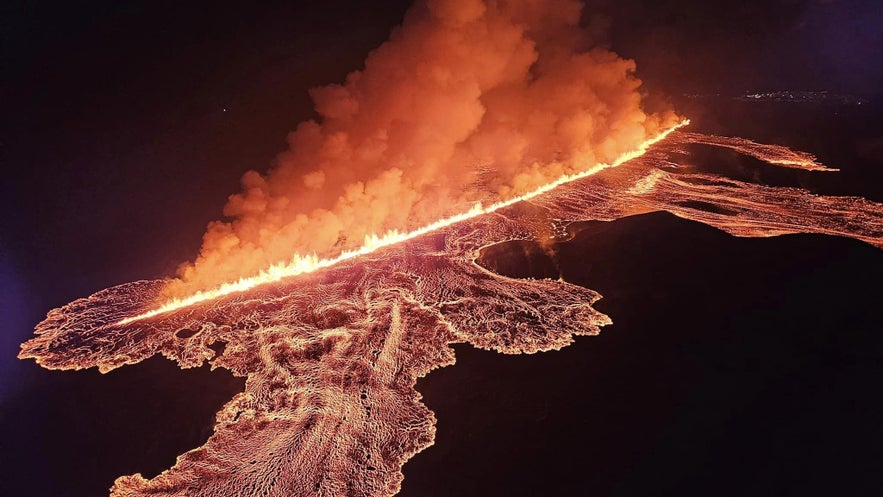 Two months passed until the earth opened again in the same location. There was a sudden increase in earthquakes on the evening of August 22nd, and within an hour, a new eruption in Sundhnukagigar started.
Two months passed until the earth opened again in the same location. There was a sudden increase in earthquakes on the evening of August 22nd, and within an hour, a new eruption in Sundhnukagigar started.
The main fissure quickly grew to 2.5 miles (4 kilometers), and shortly after, a smaller one opened up 0.6 miles to the north. This time, the eruption was further north than previous ones, which is a better location for keeping nearby infrastructure safe.
The lava started flowing fast, about 1.2 miles per hour (2 kilometers), but quickly slowed down. It followed the pattern of the previous eruptions, continuing to shrink and forming specific craters before coming to a stop on September 5th.
 Just before midnight on November 20th, volcanic activity resumed in Sundhnukagigar, marking the tenth eruption on the Reykjanes Peninsula since Fagradalsfjall volcano in 2021. The new craters opened north of Grindavik, in the same area as in August, but the eruption was much smaller in size.
Just before midnight on November 20th, volcanic activity resumed in Sundhnukagigar, marking the tenth eruption on the Reykjanes Peninsula since Fagradalsfjall volcano in 2021. The new craters opened north of Grindavik, in the same area as in August, but the eruption was much smaller in size.
Throughout the night, the new volcanic fissure stretched to 1.8 miles (3 kilometers) before starting to shrink and forming craters. The lava quickly crossed the main road to Grindavik and damaged power lines, causing a brief power outage in the town. Lava also flowed over the parking area of the Blue Lagoon, but thanks to the protective barriers, there was no risk to the spa itself or other nearby infrastructure.
Flights and travel in Iceland remained unaffected, and the eruption finally came to a close on December 9th, having lasted for 18 days. It's impossible to say when the next eruption will occur, but more are expected in the coming months. Please respect the safety closures and do not attempt to enter the eruption area. It can currently only be seen on helicopter tours.
2023 Seismic Activity and Closeness to Grindavik
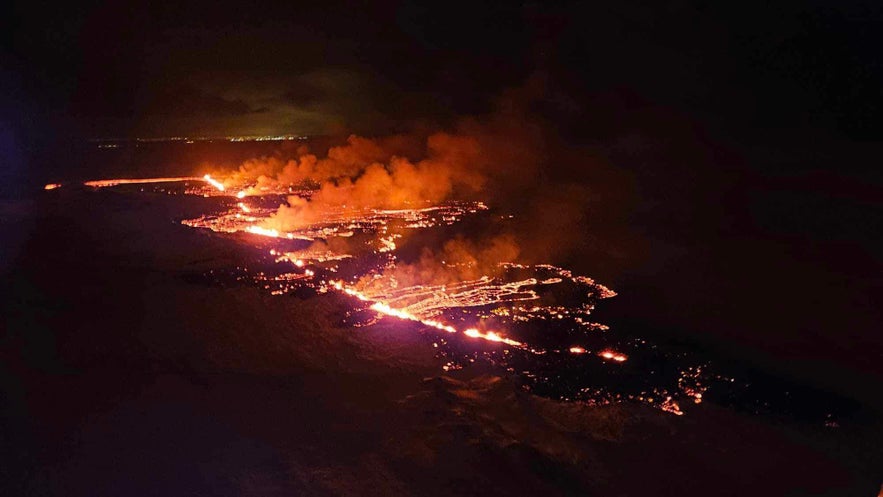
The Sundhnukagigar fissure on the night of December 18th, 2023.
Before the lava broke to the surface by Sundhnukagigar on December 18th, Icelanders had been expecting an eruption for almost two months. The preceding period had strong seismic activity, starting on October 25th, with earthquakes having destructive effects on infrastructure in the nearby town of Grindavik.
It was clear that the impending eruption was going to be larger than the previous ones in the vicinity, and for a while, it seemed likely that the lava would erupt in the middle of the town. Because of this, Grindavik was evacuated on November 10th, with residents being able to rescue animals and salvage their belongings in the weeks afterward.
This meant that on the evening of December 18th, Grindavik was mostly empty when the eruption started, with only rescue services and police close by. Nobody was harmed in this eruption, and thankfully, the lava flowed away from the nearby Grindavik, Svartsengi powerplant, and the Blue Lagoon.
The 2023 Eruption of the Sundhnukagigar Crater Row
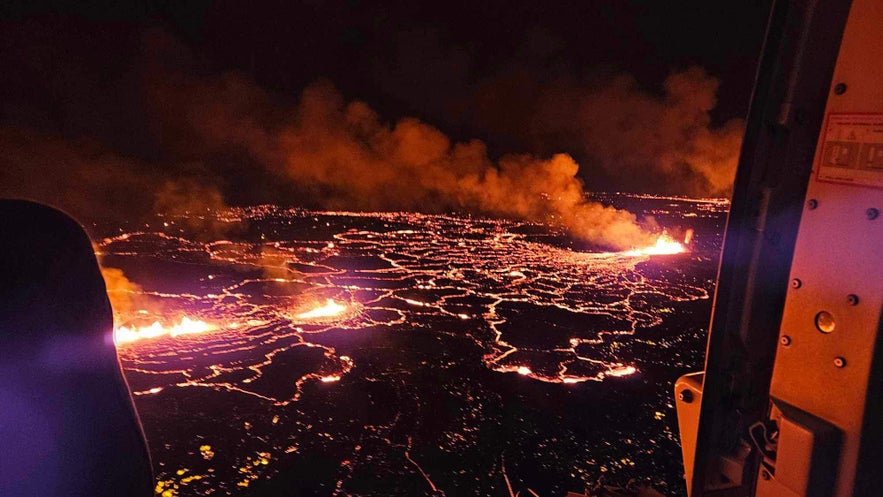
The 2023 Sundhnukagigar fissure seen from a helicopter on the first night of the eruption.
While Sundhnukagigar may be referred to as a volcano, it's actually an example of a fissure eruption when lava erupts through cracks in the earth's surface rather than a single volcanic vent.
The 2023 volcanic fissure opened at around 10 PM on December 18th and initially spanned a length of 2.5 miles (4 kilometers). Remarkably, the lava reached a height of over 328 feet (100 meters). Within just the first seven hours, the volume of lava flow had already surpassed the total output of the month-long Litli-Hrutur eruption that occurred in the summer of 2023.
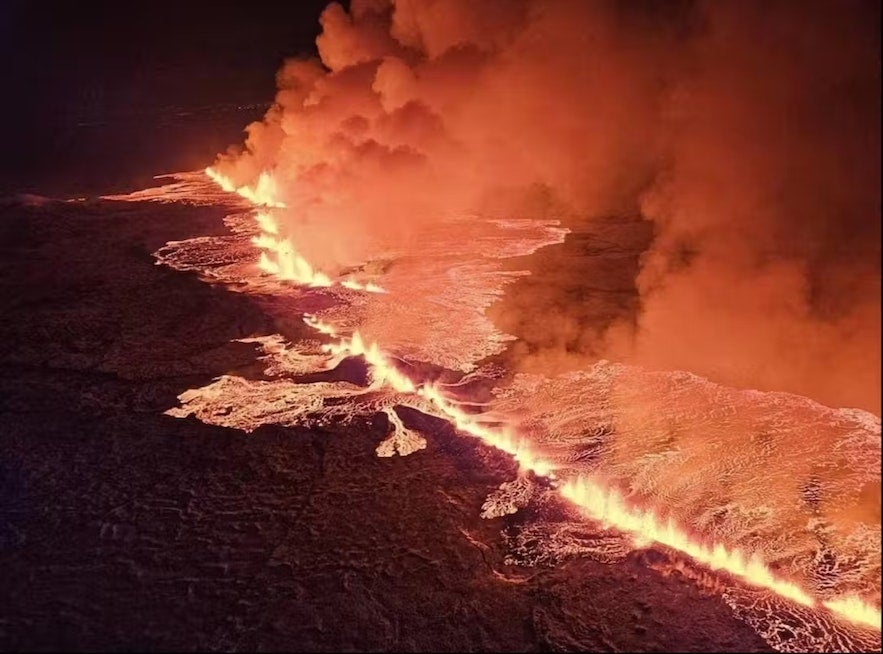
The 2023 Sundhnukagigar eruption by Grindavik.
Over the first two days, the surrounding lava field from Sundhnukagigar had reached a size of 4 square miles (3.7 square kilometers). For context, the total size of the whole lava field from the 2021 Fagradalsfjall eruption, which lasted six months, is around 5.4 square miles (5 square kilometers). The eruption slowly calmed down before coming to a stop on the morning of December 21st, 2023.
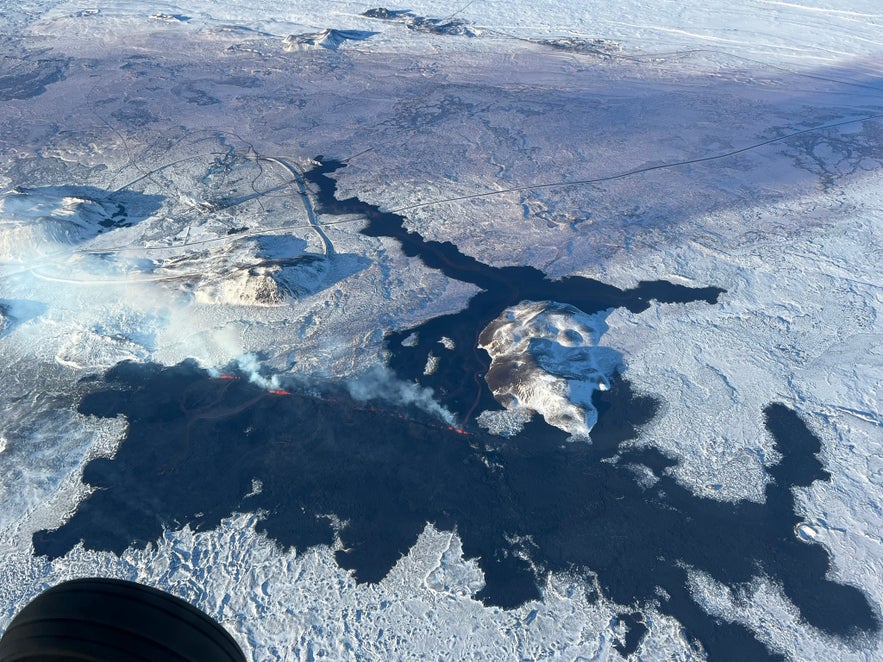
Lava flow from the February 2024 Sundhnukagigar eruption reached the Grindavik road and the main Reykjanes hot water pipe.
The Sundhnukagigar eruptions were much larger than the three previous visitor-friendly eruptions on the Reykjanes peninsula. It's likely that the short timespan of the eruptions is due to how powerful they were initially.
The volcanic eruption by Mt. Hagafell on January 14th, 2024, was smaller but much closer to Grindavik. There is still a risk of even more fissures opening in the vicinity, and there is also a great deal of dangerous gas pollution around the eruption area.
Right now, it's only possible to see the aftermath of the eruption area with helicopter tours. You can also watch a live stream of the Sundhnukagigar eruption site.
History of the Sundhnukagigar Craters
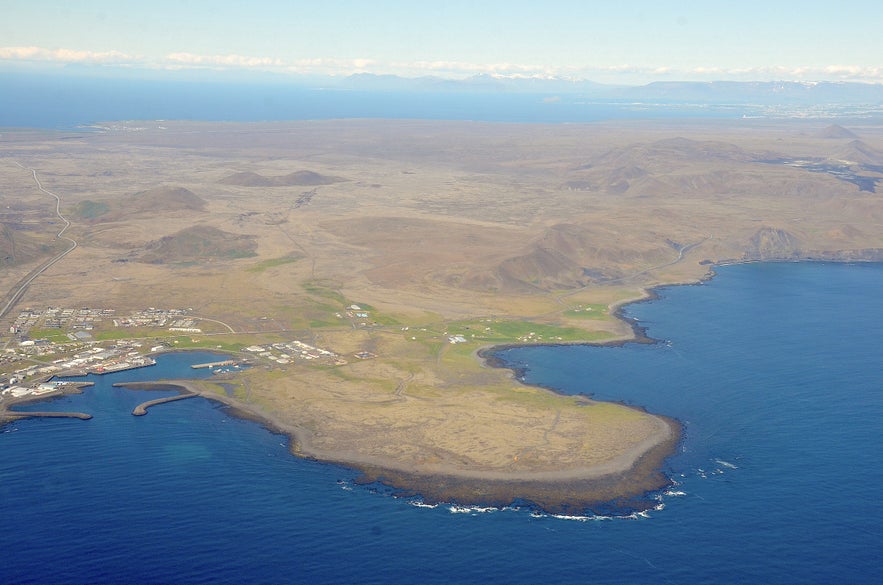
Photo from Wikimedia, Creative Commons, by TommyBee. The area in 2022. The Capital Area and lava from the Fagradallsfjall eruptions are in the top right, and Grindavik to the bottom left. Sundhnukagigar craters are the dark crack in the middle of the peninsula, above the right edge of Grindavik.
This was not the first time that the Sundhnukagigar crater row has erupted, as it was formed over 2,500 years ago during another fissure eruption. It's a common occurrence in Iceland due to its location on the Mid-Atlantic Ridge, where the North American and Eurasian tectonic plates diverge. There's even a bridge between the continents, just a 20-minute drive from the Sundhnukagigar crater row!
The name of the eruption site is derived from "Sundhnúkur," the tallest crater in the row, with "gígar" translating to "craters" in Icelandic. The "sund" component of the name is an old word marking a boat-accessible path, as the craters have historically served as navigational landmarks for sailors along the rough Reykjanes coastline.
In recent years, the area has been popular for short hiking excursions, featuring trails weaving through the crater row and adjacent lava fields. There are also historic travel routes marked by cairns around the crates, which locals have used for centuries to navigate the Reykjanes peninsula.
With the 2023 and 2024 Sundhnukagigar eruptions and the seemingly ongoing volcanic activity in the region, this landscape is steadily transforming, with vast new lava fields and craters.
Attractions Nearby
Popular categories

Download Iceland’s biggest travel marketplace to your phone to manage your entire trip in one place
Scan this QR code with your phone camera and press the link that appears to add Iceland’s biggest travel marketplace into your pocket. Enter your phone number or email address to receive an SMS or email with the download link.

